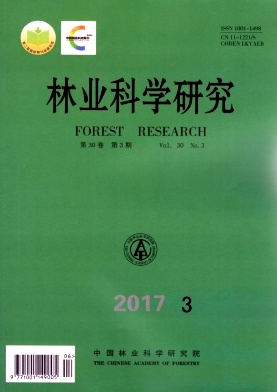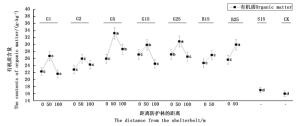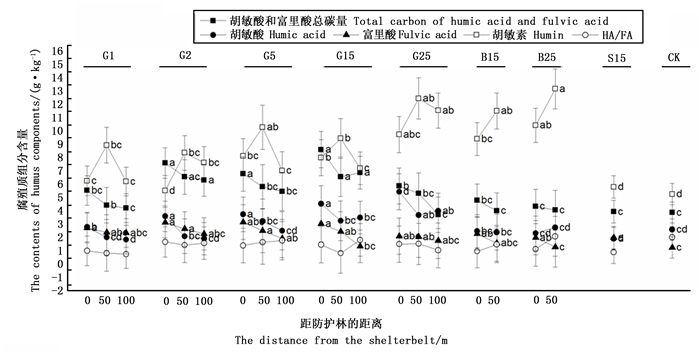-
草牧场防护林作为具有特殊功能和意义的防护林林种,不仅可以增加牧草产量,抵御鼠灾和虫害,还可以提高草原生态系统稳定性、物种多样性和景观多样性[1]。以往国内外学者偏重对农田防护林的研究[2-7],而对草牧场防护林的研究则相对较少,并且主要侧重于草牧场防护林营造技术[1]、综合效益[8]、草地生产力[9]、碳储量[10-11],以及对土壤养分、水分的改良效应[12-14]等方面,而退化草牧场防护林不同结构的配置方式和林龄对土壤腐殖质碳组分特征及其酶活性影响的研究甚少。本试验选择内蒙古赤峰市巴林右旗短角牛场作为研究区域,探讨不同防护林结构的配置、不同林龄草牧场防护林对土壤腐殖质碳组分特征和酶活性的影响及其两者的关系,旨在揭示草牧场防护林土壤性质的变化趋势,为未来选择草牧场防护林结构的配置类型提供基础数据和理论支撑。
HTML
-
研究区位于内蒙古自治区赤峰市巴林右旗短角牛场(43°12′~44°27′ N, 118°10′~120°05′ E),属巴林右旗中南部及东南部丘陵,丘间有宽广波状冲积平原和沙地,属半干旱大陆性季风气候,年均气温4.9℃,年均无霜期131 d,年均降水量357.6 mm,6—8月降水量平均占年总降水量的75.5%,年均蒸发量为2 103.0 mm,约为年降水量的6倍,平均湿润度0.35。地带性土壤为栗钙土,植被主要为草原植被类型,如草甸草原植被、沙生植被和沙滩草甸植被,造林树种主要有杨树(Populus spp.),樟子松(Pinus sylvestris var. mongolica Litvin.)、红皮云杉(Picea Koraiensis Nakai.)、油松(Pinus tabulaeformis Carr)、白榆(Ulmus pumila linn.)、胡枝子(Lespedeza bicolor Turcz.)、黄柳(Salix gordejevii Chang et SkV.)、小叶锦鸡儿(Caragana micorphylla Lam.)、沙枣(Elaeagnus angustifolia Linn.)、沙棘(Hippophae rhamnoide Linn.)、旱柳(Salix matsudana Koidz.)等,优势植物为羊草(Leymus Chinensis Trin.)。
-
在内蒙古赤峰市巴林右旗大阪镇短角牛场,选择相似立地条件不同林龄、不同结构配置类型(网格状林、带状林、疏林、无林地(对照))的草牧场防护林设置样地。试验样地概况见表 1。
防护林带结构
Shelterbelt configuration林龄
Stand age/a形状和规格
Shape and size林带宽
Shelterbelt width/m树种组成及株、行距
Tree species composition and spacing网格状防护林
Grid-shaped shelterbelt1 矩形,250 m×300 m 8.0 其中3行为杨树,1行为樟子松,株行距为2.0 m×2.5 m,杨树和樟子松之间距离为3.0 m。 2 矩形,250 m×300 m 8.0 其中3行为杨树,1行为樟子松,株行距为2.0 m×2.5 m,杨树和樟子松之间距离为3.0 m。 5 矩形,200 m×250 m 16.0 其中3行为杨树,4行为沙棘,杨树株行距为2.5 m×2.5 m,沙棘株行距为2.0 m×2.0 m,杨树和沙棘之间的距离为3 m。 15 矩形,250 m×300 m 10.0 其中3行为杨树,2行为沙棘,杨树株行距为2.5 m×2.5 m,沙棘株行距为2.0 m×2.0 m,杨树和沙棘之间的距离为3 m,在草牧场防护林庇护下的草场内,一部分草场有耕作过的痕迹。 25 矩形,300 m×400 m 8.0 其中3行为杨树,1行为樟子松,株行距为2.5 m×2.5 m,杨树和樟子松之间距离为3.0 m,在草牧场防护林庇护下的草场内,也有耕作过和人车践踏以及踩实的痕迹。 带状防护林
Belt-shaped shelterbelt15 带状 8.0 5行均为旱柳,株行距为2.0 m×2.0 m,带间距为100 m。 25 带状 5.0 3行均为杨树,株行距为2.5 m×2.5 m,带间距为100 m。 疏林状防护林
Sparse-shaped shelterbelt15 不规则 — 草场面积约为0.18 km2,树种为杨树,树木生长缓慢,株间距较远,且分布不均匀,共有杨树50余株。 无林草牧场(对照)
Pastureland without forest (control)— — — 面积约为1 km2,与25年生网格状草牧场防护林毗邻和接壤。 Table 1. General situation of experimental plots
在网格状防护林短边的中点处,按离开其距离0 m(带内)、50 m和100 m分别设置3块样地。带状防护林按防护距离0 m(林内)和50 m分别设置2块样地(图 1)。疏林和无林草牧场在其内部不同位置设置3块样地,采集0~20 cm土壤样品,并作3次重复。将野外采集土壤装袋、标号运回实验室后,分成2份,一份鲜样捡出石块、根系后,过筛(2 mm)后储藏于4℃冰箱内保存,用于土壤酶的测定,另一份经风干、研磨、过筛(0.25 mm)后装瓶保存,用于其他指标的测定。
-
土壤有机质含量测定采用重铬酸钾硫酸氧化法[15];腐殖质分组测定采用熊毅-傅积平改进法[16];过氧化氢酶测定采用容量法,活性以0.1 mol·L-1KMnO4 mL·g-1表示;多酚氧化酶测定采用碘量滴定法,活性以0.01 mol·L-1I2 mL·g-1表示;蔗糖酶的测定方法采用比色法,活性以葡萄糖mg·g-1表示;脲酶的测定方法采用比色法,活性以NH3-N mg·g-1表示;蛋白酶的测定方法采用氨基氮比色法,活性以NH2-N mg·g-1表示;磷酸酶的测定方法采用磷酸苯二钠比色法,活性以酚mg·g-1表示[17-18]。
-
数据均采用Microsoft Excel 2003进行整理和统计,采用IBM SPSS Statistics 18.0软件进行单因素方差分析(one-way ANOVA)和相关性分析,采用AutoCAD 2008和origin7.5进行绘图。
1.1. 研究区概况
1.2. 样地设置与样品采集
1.3. 样品测定
1.4. 数据分析
-
从图 2可以得出:对于网格状防护林,距林带0 m处(林内)不同林龄(1、2、5、15、25年)的土壤有机质含量分别显著高于无林草牧场(对照)39.77%、43.29%、62.80%、70.26%、70.33%(P < 0.05),且随着林龄的增大而增大;距林带50 m处林龄为5、15、25年的土壤有机质含量分别比0、100 m处提高27.90%、15.77%;10.06%、21.92%;13.66%、16.32%(P < 0.05),林龄为1年和2年的土壤有机质含量比0、100 m处的高,但其间的差异未达到显著水平。在带状防护林中,距林带50 m处林龄25年的土壤有机质含量比距离林带0 m处的提高16.63%(P < 0.05),林龄为15年的比0 m处的高,但其间差异未达到显著水平。各林龄网格状、带状草牧场防护林土壤有机质含量与无林草牧场相比均显著提高,而疏林草牧场防护林土壤有机质含量有所提高,但未达到显著水平。同林龄网格状防护林土壤有机质含量较带状和疏林状具有明显优势。
-
从图 3可以得出:对于网格状草牧场防护林,不同林龄(1、2、5、15、25年)距林带0 m处土壤胡敏酸碳组分含量较50 m处分别提高了37.56%、70.42%、15.95%、38.91%、47.44%(P < 0.05);较100 m处分别提高了50.00%、86.15%、48.82%、29.46%、35.73%(P < 0.05);林龄为1年和2年距林带50、100 m及林龄为5年距林带100 m处土壤胡敏酸碳组分含量均低于对照,且除林龄为1年100 m处土壤胡敏酸碳组分含量与对照差异显著外,其余均未达到显著水平;林龄为5、15、25年距林带0、50、100 m处土壤胡敏酸碳组分含量均显著高于对照。带状防护林各处土壤胡敏酸碳组分含量与对照较接近,其间的差异均未达到显著水平。疏林状防护林土壤胡敏酸碳组分含量显著低于对照。各防护林结构的配置方式中土壤胡敏酸碳组分含量大小排序为网格状>无林地>带状>疏林。
-
从图 3可以看出:对于网格状草牧场防护林,不同林龄(1、2、5、15、25年)距林带0 m处土壤富里酸碳组分含量最高,随着距林带距离的增加,土壤富里酸碳组分含量降低,但相同林龄的差异均未达到显著水平;距林带0 m处林龄为5年的土壤富里酸碳组分含量最高,较对照提高了149.22%(P < 0.05),距林带50 m处林龄为2年的最高,较对照提高了109.38%(P < 0.05),距林带100 m处林龄为1年的最高,但与对照相比,其间的差异未达到显著水平。对于带状草牧场防护林,林龄25年距林带0 m处比50 m处土壤富里酸碳组分含量显著提高了54.20%(P < 0.05),林龄15年距林带0 m处高于50 m处,但其差异未达到显著水平;不同林龄(15、25年)距林带0 m处土壤富里酸碳组分含量比对照显著提高了81.25%、57.81%(P < 0.05),距林带50 m处也高于对照,但其差异未达到显著水平。疏林状草牧场防护林土壤胡敏酸碳含量比对照显著提高了58.59%。各防护林结构的配置林地中土壤富里酸碳组分大小排序为网格状>带状>疏林>无林地。
-
从图 3可以看出:对于网格状草牧场防护林,距林带0、50、100 m林龄为25年的土壤胡敏素含量最大,较对照分别提高了84.69%、135.92%、118.71%(P < 0.05);相同林龄50 m处的高于0、100 m处,但其差异均未达到显著水平。对于带状草牧场防护林,相同林龄50 m处土壤胡敏素含量高于0 m处,但其差异未达到显著水平;相同林龄相同位置(0、50 m)的带状草牧场防护林土壤胡敏素含量高于网格状草牧场防护林,但其差异均未达到显著水平;距林带0、50 m林龄为25年的土壤胡敏素含量最大,较对照显著提高了97.73%、149.53%(P < 0.05)。疏林状草牧场防护林略高于对照,但其差异未达到显著水平。各防护林结构的配置林地中土壤胡敏素含量大小排序为带状>网格状>疏林>无林地。
-
从图 3可以看出:对于网格状草牧场防护林,从林龄1年到林龄25年随着林龄的增长,土壤胡敏酸和富里酸总碳量的变化呈波动趋势;相同林龄条件下,随距林带距离的增加,土壤胡敏酸和富里酸总碳量减少,但其差异未达到显著水平;距林带0、50、100 m处林龄为15年的均最大,较对照分别显著提高了120.97%、68.80%、76.73%(P < 0.05)。带状草牧场防护林各处和疏林状草牧场防护林的土壤胡敏酸和富里酸总碳量略高于对照,但其差异未达到显著水平。
-
从图 3可以看出:对于网格状草牧场防护林,距林带0 m处林龄为2年的土壤HA/FA最大值为1.70,50 m处林龄为5年时最大值为1.68,100 m处林龄为15年最大值为1.85,且均小于对照(2.05)。对于带状草牧场防护林,距0、50 m处林龄为25年的土壤HA/FA值最大,且距林带50 m处的(2.12)大于对照(2.05)。疏林状草牧场防护林的土壤HA/FA较对照减小了1.12。
-
从表 2可以看出:对于网格状草牧场防护林,距林带0、50、100 m处,随着林龄的增长,土壤过氧化氢酶活性呈增高-降低的趋势,且在2年时达到最大值,较对照显著提高了135.00%、80.00%、50.00%(P < 0.05);不同林龄(1、2、5、15、25年)0 m处比50 m和100 m处分别显著增加了15.38%,25.00%;30.56%,56.67%;18.18%,30.00%;32.14%,85.00%;20.00%,87.50%(P < 0.05)。对于带状草牧场防护林,不同林龄(15、25年)不同位置(0、50 m)的土壤过氧化氢酶活性较接近,且与对照也较接近,其差异均未达到显著水平。疏林状草牧场防护林较对照显著增加了35.00%(P < 0.05)。不同结构的配置草牧场中土壤过氧化氢酶活性大小排序为网格状>疏林>带状>无林草地。
防护林带配置
Shelterbelt configuration林龄
Stand age/a离防护林距离
Distance from the shelter/m酶活性Enzyme activities 过氧化氢酶
Catalase 0.1 mol·L-1 KMnO4/(mL·g-1)多酚氧化酶
Polyphenol oxi-dase 0.01 mol·L-1 I2/(mL·g-1)蔗糖酶
Saccharase C6H12O6/(mg·g-1)脲酶Urease NH3-N /(mg·g-1) 蛋白酶Protease NH2-N /(mg·g-1) 磷酸酶
Phosphatase Phenol/(mg·g-1)网格状防护林
Grid-shaped shelterbelt1 0 0.30±0.17d 11.88±1.99f 23.31±1.17a 39.98±1.99d 9.73±1.17d 3.37±1.17abc 50 0.26±0.06e 13.53±2.09e 21.24±1.06ab 41.77±2.09 8.31±1.06de 3.47±1.06abc 100 0.24±0.12efg 11.83±2.19f 24.43±1.22a 43.82±2.19 7.36±1.22e 2.84±1.22abc 2 0 0.47±0.17a 14.88±2.42d 23.36±1.17a 48.39±2.42c 13.29±1.17b 4.07±1.17a 50 0.36±0.22b 16.01±2.32bc 24.48±1.22a 46.53±2.33cd 11.94±1.13bc 4.19±1.22a 100 0.30±0.25cd 16.12±1.64bc 24.69±1.23a 32.80±1.64fg 11.31±1.23c 3.41±1.23ab 5 0 0.39±0.167a 14.15±2.78d 23.34±1.17a 55.86±2.79a 15.11±1.17a 4.07±1.16a 50 0.33±0.16d 17.56±2.61a 23.27±1.16a 52.33±2.62b 13.21±1.16b 3.97±1.15a 100 0.30±0.06cd 15.60±2.56c 21.19±1.06ab 51.11±2.56bcd 11.23±1.06c 3.09±1.06abc 15 0 0.37±0.08b 15.34±2.53cd 20.39±1.02ab 50.61±2.53bc 14.47±1.02a 3.97±1.02a 50 0.28±0.09d 12.4±2.47ef 24.25±1.21a 49.33±2.47c 13.52±1.21ab 3.85±1.21a 100 0.20±0.08g 13.02±2.38e 19.26±0.96b 47.54±2.38cd 11.39±0.96c 3.66±0.96ab 25 0 0.30±0.09d 14.88±1.79d 17.86±0.89b 35.78±1.79e 14.47±0.89a 3.56±0.89abc 50 0.25±0.08f 13.02±1.71e 17.90±0.90b 34.28±1.71fg 13.05±0.89b 3.31±0.90abc 100 0.16±0.11g 13.53±1.68e 22.10±1.11ab 33.57±1.68fg 12.42±1.11bc 3.15±1.11abc 带状防护林
Belt-shaped shelterbelt15 0 0.22±0.15g 13.03±1.64e 23.00±1.15ab 32.70±1.64fg 15.03±1.15a 3.44±1.15a 50 0.19±0.07g 13.05±1.51e 17.40±0.87b 30.14±1.50g 9.97±0.87d 2.21±0.87bc 25 0 0.21±0.17g 11.23±1.31f 9.3±0.47c 26.12±1.31h 15.50±0.47a 3.78±0.47a 50 0.19±0.05g 13.02±1.29e 9.00±0.45c 25.80±1.29h 11.94±0.45bc 2.43±0.45b 疏林状防护林
Sparse-shaped shelterbelt15 - 0.27±0.14d 11.81±1.50f 20.8±1.04ab 30.03±1.50g 8.94±1.04d 2.18±1.04c 无林草牧场(对照)
Pastureland without forest (control)- - 0.20±0.09g 10.79±1.30f 19.70±0.99b 26.04±1.31h 9.41±0.99d 2.65±0.97b Table 2. Soil enzyme activities for different structural configurations of pastureland shelterbelts
-
从表 2可以看出:对于网格状草牧场防护林,距林带0 m处林龄为15年的土壤多酚氧化酶活性在所有林龄中最强,较对照显著增加42.17%(P < 0.05);距林带50 m处林龄为5年的在所有林龄中最强,较对照显著增加62.74%(P < 0.05);距林带100 m处林龄为2年的在所有林龄中最强,较对照显著增加49.40%(P < 0.05)。对于带状草牧场防护林,距林带0、50 m处林龄为15年的土壤多酚氧化酶活性在所有林龄中最强,与对照相比显著增强了20.76%、20.95%(P < 0.05);林龄为15年的带状防护林与网格状防护林相比,0 m处减小了15.06%,50 m处较接近,其差异未达到显著水平。疏林状草牧场防护林的土壤多酚氧化酶活性略强于对照,其差异也未达到显著水平。不同结构的配置草牧场防护林中土壤多酚氧化酶活性大小排序为网格状>带状>疏林>无林草地。
-
从表 2可以看出:对于网格状草牧场防护林,距林带0 m处林龄为1、2、5年的土壤蔗糖酶活性均较为接近,其间的差异均未达到显著水平,但比对照分别显著增加了18.32%、18.58%、18.48%(P < 0.05),林龄为15年的略大于对照、林龄为25年的略小于对照,且其差异均未达到显著水平;距林带50 m处林龄为2、5、15年的相互较为接近,其差异均未达到显著水平,但均比对照分别显著提高24.26%、18.12%、23.10%(P < 0.05),林龄为1年和25年的土壤蔗糖酶活性与对照较为接近,其差异未达到显著水平;距林带100 m处林龄为1、2年的也相近,其差异未达到显著水平,但均比对照分别显著增大了24.01%、25.33%(P < 0.05),林龄为5、15、25年与对照也较为接近,其差异均未达到显著水平。对于带状草牧场防护林,林龄为15年距林带0 m的土壤蔗糖酶活性强于对照,距林带100 m的小于对照,但两者与对照的差异均未达到显著水平;林龄为25年距林带0、50 m的比对照显著减小52.79%、54.31%。疏林状草牧场防护林的土壤蔗糖酶活性略强于对照,但其差异未达到显著水平。
-
从表 2可以看出:对于网格状草牧场防护林,距林带0、50、100 m处,随着林龄的增长,土壤脲酶活性呈升高-降低的趋势,且在5年时达到最大值,较对照显著提高了114.85%、101.27%、96.58%(P < 0.05);林龄为1年时,随着距林带距离的增加,土壤脲酶活性增强,林龄为2、5、15、25年随着距林带距离的增加,土壤脲酶活性减弱,但所有的网格状草牧场防护林的土壤脲酶活性都显著高于对照。对于带状草牧场防护林,距林带0、50 m处土壤脲酶活性随着林龄的增加表现为降低的趋势,且林龄为25年的土壤脲酶活性与对照接近,其差异未达到显著水平。疏林状草牧场防护林的土壤脲酶活性较同林龄网格状的显著降低,与同龄的带状的较接近,其差异未达到显著水平,但比对照显著提高15.38%。
-
从表 2可以看出:对于网格状草牧场防护林,不同林龄(1、2、5、15、25年)距林带0 m处土壤蛋白酶活性最强,随着距林带距离增加,其活性降低;距林带0 m处林龄为5年最大,较对照显著提高60.57%(P < 0.05),距林带50 m处林龄为15年最大,较对照显著提高43.68%(P < 0.05),距林带100 m处林龄为25年最大,较对照显著提高了31.99%(P < 0.05)。对于带状草牧场防护林,随着林龄的增加,距林带0、50 m处土壤蛋白酶活性表现出降低的趋势;林龄为15年距林带0 m的比对照显著增加了59.72%(P < 0.05),距林带100 m的与对照接近,其差异未达到显著水平;林龄为25年距林带0、50 m的比对照分别显著提高64.72%、26.89%(P < 0.05)。疏林状草牧场防护林的土壤蛋白酶活性显著低于同林龄的网格状和带状的,与对照较接近,其差异未达到显著水平。
-
从表 2可以看出:对于网格状草牧场防护林,不同林龄(1、2、5、15、25年)距林带0 m处土壤磷酸酶活性最强,随着距林带距离增加,其活性降低;距林带0 m处林龄为2年和5年时期活性相同且最强,较对照显著提高了53.58%(P < 0.05)。对于带状草牧场防护林,距林带0 m处林龄为15年和25年的土壤磷酸酶活性与同龄同位置的网格状的较接近,其差异未达到显著水平,与对照分别提高了29.81%、42.64%;距林带50 m处林龄为15年和25年的与对照差异不显著。疏林状草牧场防护林的土壤磷酸酶活性显著低于同林龄的网格状和带状的,比对照显著降低了17.74%(P < 0.05)。不同结构的配置草牧场防护林中土壤磷酸酶活性大小排序为网格状>带状>无林草地>疏林。
-
为了更好地探讨防护林土壤酶活性与土壤腐殖质有机碳组分之间的关系,将6种土壤酶与各腐殖质组分进行相关性分析(表 3)。结果表明,过氧化氢酶分别与(胡敏酸和富里酸)总碳量、富里酸呈极显著正相关,分别与胡敏酸、胡敏素呈不显著的正相关、负相关。多酚氧化酶与(胡敏酸和富里酸)总碳量呈极显著正相关,与胡敏酸、富里酸和胡敏素均呈不显著正相关。蔗糖酶分别与富里酸、胡敏素呈极显著正相关、显著负相关,分别与(胡敏酸和富里酸)总碳量、胡敏酸呈不显著的正相关、负相关。脲酶分别与(胡敏酸和富里酸)总碳量、富里酸呈极显著正相关,分别与胡敏酸、胡敏素呈不显著的正相关、负相关。蛋白酶分别与(胡敏酸和富里酸)总碳量、胡敏酸呈显著、极显著正相关,分别与富里酸、胡敏素呈不显著正相关。磷酸酶与(胡敏酸和富里酸)总碳量、富里酸均呈极显著正相关,分别与胡敏酸、胡敏素呈不显著的正相关、负相关。
项目Items 过氧化氢酶
Catalase多酚氧化酶
Polyphenol oxidase蔗糖酶
Saccharase脲酶
Urease蛋白酶
Protease磷酸酶
Phosphatase(胡敏酸和富里酸)总碳量
Total carbon of HA and FA0.772** 0.560** 0.365 0.725** 0.470* 0.765** 胡敏酸HA 0.249 0.261 -0.062 0.276 0.592** 0.391 富里酸FA 0.857** 0.422 0.560** 0.657** 0.317 0.690** 胡敏素Humin -0.420 0.091 -0.533* -0.304 0.386 -0.076 ** 和* 表示极显著(P < 0.01)和显著(P < 0.05)相关。** and * mean significant and highly significant correlation at 0.01 and 0.05, respectively. Table 3. Correlation coefficient between soil enzyme activity and its humus component
2.1. 土壤有机质含量变化特征
2.2. 土壤腐殖质有机碳组分特征
2.2.1. 土壤胡敏酸组分
2.2.2. 土壤富里酸组分
2.2.3. 土壤胡敏素
2.2.4. 胡敏酸和富里酸总碳量
2.2.5. 胡敏酸/富里酸(HA/FA)
2.3. 草牧场防护林土壤酶活性
2.3.1. 土壤过氧化氢酶活性
2.3.2. 土壤多酚氧化酶活性
2.3.3. 土壤蔗糖酶活性
2.3.4. 土壤脲酶活性
2.3.5. 土壤蛋白酶活性
2.3.6. 土壤磷酸酶活性
2.4. 土壤腐殖质有机碳组分与土壤酶活性相关性
-
本项研究结果表明,所有草牧场防护林的土壤有机质含量均高于对照;林龄为1年到5年网格状草牧场防护的土壤富里酸碳组分、胡敏素含量随林龄的增大而增加,林龄5年以后降低,这与已有的研究结果,草牧场防护林下土壤水稳性团聚体和有机质质量分数增加[13],增加防护林带后根系碳储量和土壤碳储量增加[19];胡敏酸和胡敏素在幼龄林到近成熟林增加,富里酸和胡敏素在近成熟林到成熟林降低[20]的结论基本一致,不同的是1~25生年距离防护林50 m处土壤有机质含量高于0和100 m的。同林龄防护林土壤有机质含量网格状大于带状,各林龄网格状、带状和疏林草牧场防护林土壤有机质含量均高于对照。分析认为,退化草牧场本身的有机质和腐殖质含量很低,在营造防护林后,短期内为退化草牧场输入较多的有机质,并且积累形成腐殖质,随着防护林生长年限的延长,林冠郁闭度增大,根系愈加密集,枯落物多且周转快,其分解及利用程度大于输入的养分量,造成其防护林根系周围一段距离内(< 50 m)有机质和腐殖质量的降低,稍远的距离(>50 m而 < 100 m)林木根系无法吸收与利用,导致有机质和腐殖质的积累。超过一定距离后,防护林的凋落物无法到达,因此有机质缺乏。网格状防护林四周树木的遮挡及其防风效应有效防止凋落物随风飘散,因此林内养分分布相对比较均匀,生物量高,而带状防护林凋落物因风等自然因素的搬运作用而比较分散,因而在一定情况下网格状防护林养分高于带状防护林。
土壤酶活性可以作为衡量土壤生物学活性、土壤生产力、土壤肥力和土壤退化的重要指标[17, 21-24],也可以间接地了解或预测某些营养物质的转化情况[25-28]。本研究表明,5年生到25年生网格状草牧场防护林土壤脲酶、过氧化氢酶、多酚氧化酶活性随着林龄的增加而减小;蔗糖酶活性变化不明显,与对照相比,未达到显著水平;土壤脲酶、过氧化氢酶活性随防护林距离的增大而降低。带状草牧场防护林土壤脲酶、蔗糖酶、过氧化氢酶和多酚氧化酶活性为林龄15年高于25年;土壤脲酶、蔗糖酶和过氧化氢酶活性0 m高于50 m处。带状草牧场防护林土壤多酚氧化酶和过氧化氢酶活性高于对照;疏林草牧场防护林土壤脲酶、蔗糖酶和过氧化氢酶活性均高于对照。因此由土壤酶活性做为衡量指标来说,防护林在一定程度上可以提升草牧场的土壤生物学活性、土壤生产力、土壤肥力等,且5年生网格状防护林的提升效果最佳。
本研究结果表明:不同结构配置类型土壤酶活性与胡敏酸和富里酸总碳量、胡敏酸组分、富里酸组分、胡敏素组分均有相关性。胡敏酸和富里酸总碳量与过氧化氢酶、脲酶、磷酸酶呈极显著正相关,这说明利用酶来标识土壤肥力存在信息上的重叠[29]。胡敏酸与蛋白酶呈极显著正相关,这与张晓曦[30]的研究结果胡敏酸与蛋白酶呈显著正相关相似。富里酸与过氧化氢酶、蔗糖酶、脲酶、磷酸酶呈极显著正相关,与矫丽娜[31]的研究结果富里酸与脲酶显著正相关,与蔗糖酶极显著正相关相似。不同的是胡敏素与蔗糖酶呈极显著负相关,且胡敏素与过氧化氢酶、脲酶、磷酸酶也表现出较小的负相关。可能与退化草牧场独特的环境因素有关,但具体原因还有待进一步深入探讨。
-
防护林在一定程度上可以提升草牧场土壤有机质、腐殖质的含量及酶活性,对比分析不同结构的配置类型和林龄发现,林龄为5年的网格状防护林的提升效果最佳。对防护林及其多数土壤腐殖质碳组分和酶活性的分析表明,网格状防护林的带间距应小于200 m。









 DownLoad:
DownLoad:

